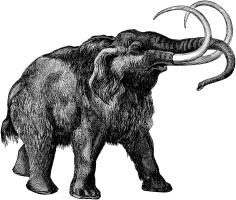 Woolly MammothTwo years ago, the skeleton of a mammoth was discovered and excavated right near the San Jose airport. That may not change your world, but consider that when that mammoth was alive, there was no San Francisco Bay-- global sea level was lower because of massive glaciers that covered the Northern Hemisphere. This time period, known as the Pleistocene, was the heyday of the iconic animals of the Ice Ages: saber-toothed cats, woolly mammoths, dire wolves, and giant ground sloths. These so-called charismatic megafauna are powerful reminders that California, even several thousand years ago, was far different than it was today.
Woolly MammothTwo years ago, the skeleton of a mammoth was discovered and excavated right near the San Jose airport. That may not change your world, but consider that when that mammoth was alive, there was no San Francisco Bay-- global sea level was lower because of massive glaciers that covered the Northern Hemisphere. This time period, known as the Pleistocene, was the heyday of the iconic animals of the Ice Ages: saber-toothed cats, woolly mammoths, dire wolves, and giant ground sloths. These so-called charismatic megafauna are powerful reminders that California, even several thousand years ago, was far different than it was today.
Paleontologists and archaeologists have long debated what happened to these large Ice Age mammals: were they the victims of rapid climate change or did they fall to the spears of a superpredator, invading from the Bering land bridge? Across other continents and islands, the pattern of megafaunal extinction varies in timing (when humans arrive) and in magnitude (how many went extinct), and, at least in North America, it seems both climate change and human hunting played major roles. Even the condor, a vestige of the Ice Age, would have gone extinct without intervention.
Recently, a group of researchers have proposed that reintroducing the living relatives extinct North America megafauna might help fill empty or "ghost" niches that have been vacant since the Pleistocene. This means bringing back camels and elephants to large untamed parts of North America, assuming that key ecosystem functions (and services) may be restored. Supporters of the proposal point out that many African mammals already live quite well in North America (big cat ranches in Texas), and point out that many native plant species likely coevolved with Ice Age megafauna. Aside from the problems of re-wilding North America with large mammals (if you think California has a cougar problem, imagine what lions would do), critics also point out that it's impossible to reset climate variables to the Pleistocene. As cool as it would be to have Marty Stouffer narrate a Re-Wild America, I can't help but ask: why try to turn back the clock to the Pleistocene? Why not 1555? Or 1905? With evolution and ecology, what's "natural" is all a matter of the context and questions that you're asking.
Nick Pyenson is a PhD candidate at the University of California, Berkeley, in the department of integrative biology and the museum of paleontology.
